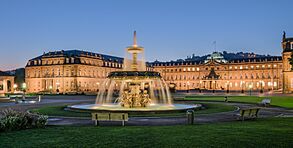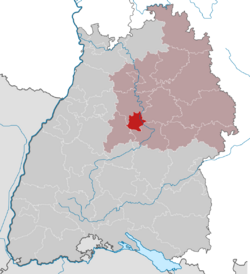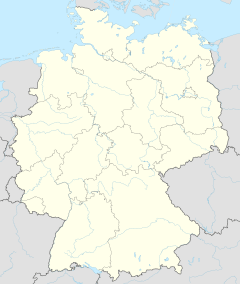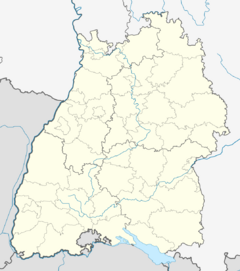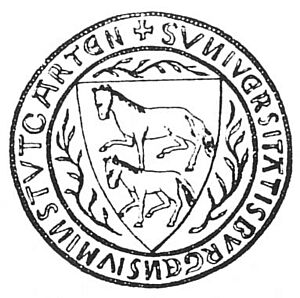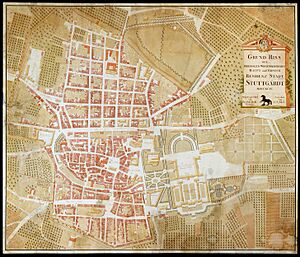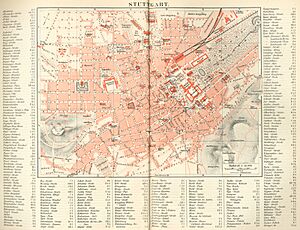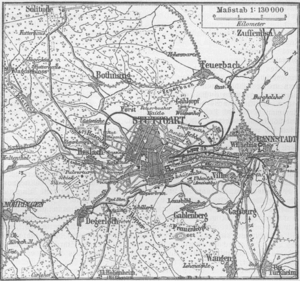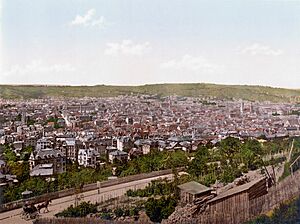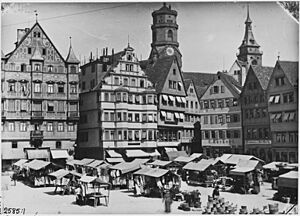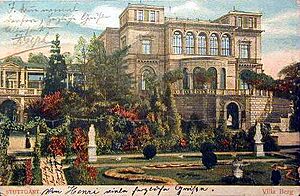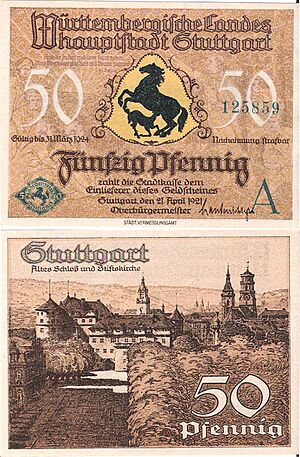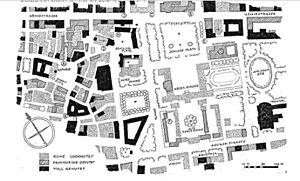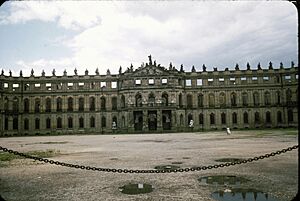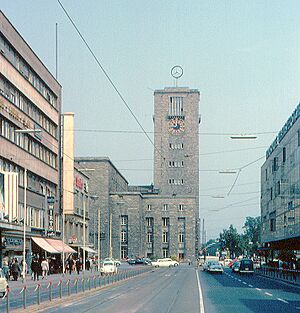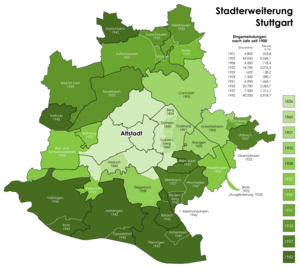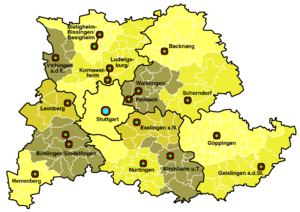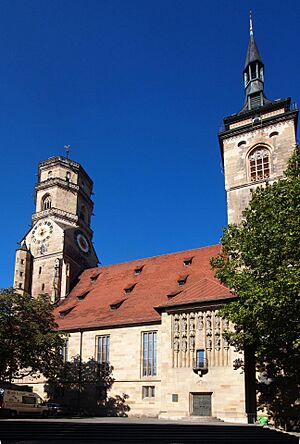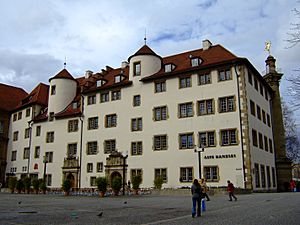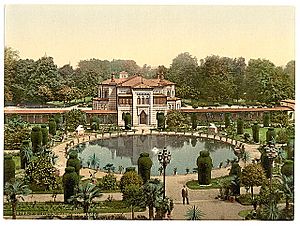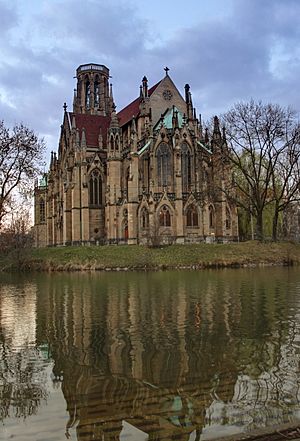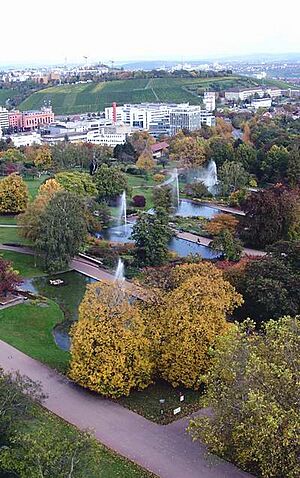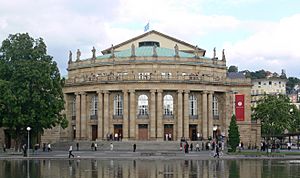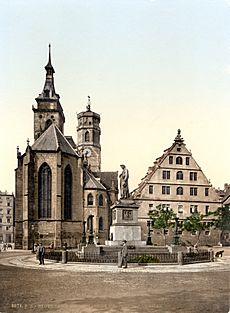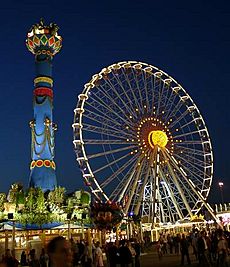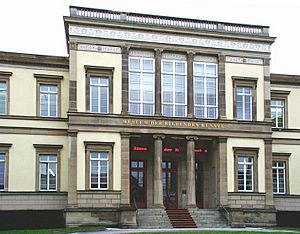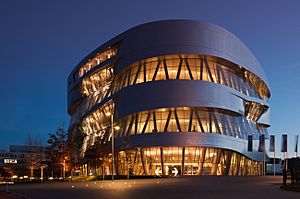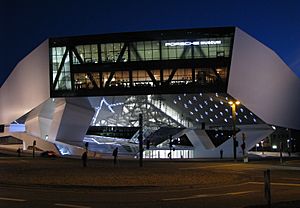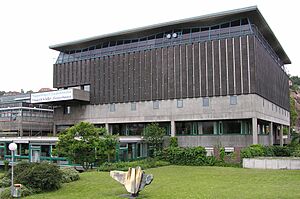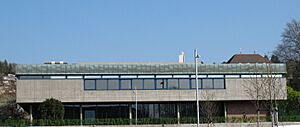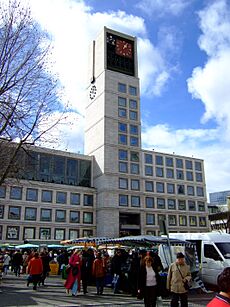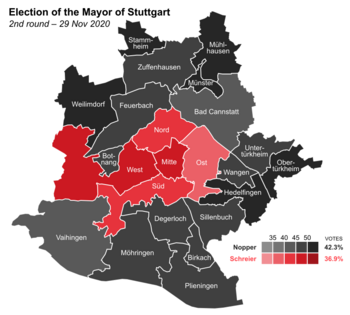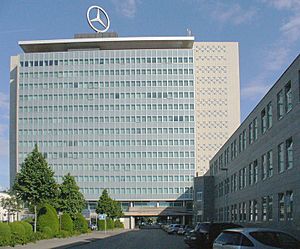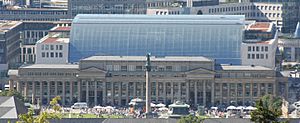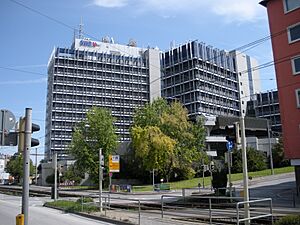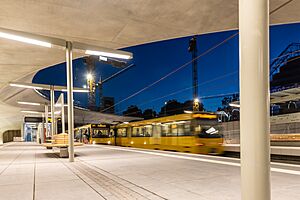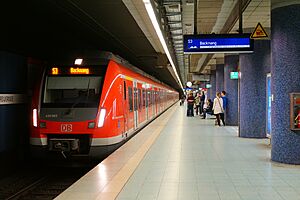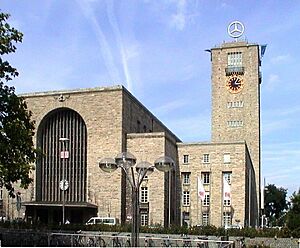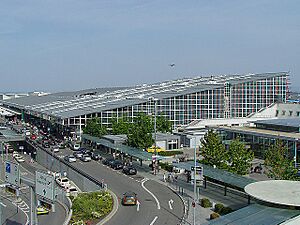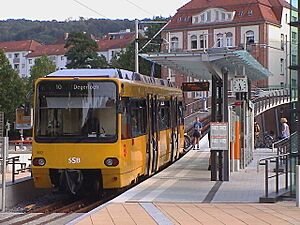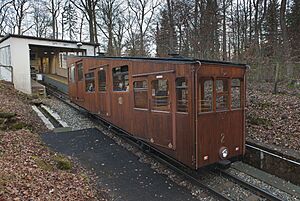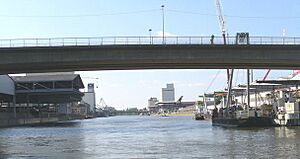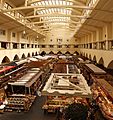Stuttgart facts for kids
Quick facts for kids
Stuttgart
|
|||
|---|---|---|---|
|
Castle Square with New Palace
Marquardtbau
Mount Württemberg
Kunstgebäude
Market Square
Cannstatt Wasen
Mercedes-Benz Welt
|
|||
|
|||
| Country | Germany | ||
| State | Baden-Württemberg | ||
| Admin. region | Stuttgart | ||
| District | Stadtkreis | ||
| Founded | 10th century | ||
| Subdivisions | 23 districts | ||
| Area | |||
| • Municipality | 207.33 km2 (80.05 sq mi) | ||
| Elevation | 245 m (804 ft) | ||
| Population
(2022-12-31)
|
|||
| • Municipality | 632,865 | ||
| • Density | 3,052.45/km2 (7,905.82/sq mi) | ||
| • Urban | 2,787,724 (31 Dec 2018) | ||
| • Metro | 5,465,093 (2021) | ||
| Demonym(s) | Stuttgarter | ||
| Time zone | UTC+01:00 (CET) | ||
| • Summer (DST) | UTC+02:00 (CEST) | ||
| Postal codes |
70173–70619
|
||
| Dialling codes | 0711 | ||
| Vehicle registration | S | ||
| Website | stuttgart.de | ||
Stuttgart is the capital and largest city of the German state of Baden-Württemberg. It sits in a green valley by the Neckar river. The city is surrounded by hills, some covered in vineyards. Stuttgart is about an hour away from the Swabian Jura mountains and the Black Forest.
With a population of over 630,000 people, Stuttgart is the sixth largest city in Germany. More than 2.8 million people live in its wider region. Nearly 5.5 million people live in its metropolitan area. This makes it the fourth largest metropolitan area in Germany. Stuttgart is known for its strong economy and high quality of life. It is also famous as the "cradle of the automobile." This means it's where the first cars were invented!
Contents
The Name of Stuttgart
Stuttgart is sometimes called the "Swabian metropolis." This is because it is in the middle of Swabia, a region where people speak a special German dialect. The name "Stuttgart" comes from an old German word, Stuotgarten. This means "stud farm." The city was founded in 950 AD by Duke Liudolf of Swabia. He wanted a place to breed warhorses.
In local dialects, the name can sound like "Schtuegert" or "Stuagart." These versions often drop the "T" sound in the middle.
A Look at Stuttgart's Past
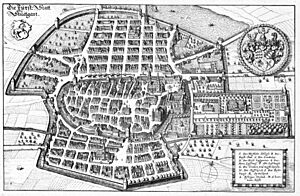

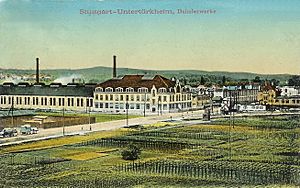
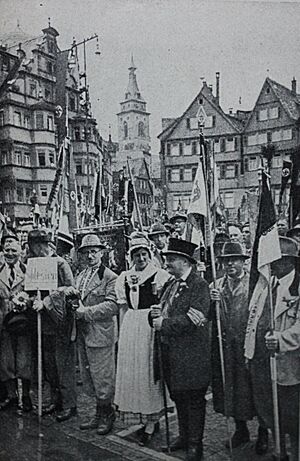
Ancient Times
The Stuttgart area has been important for farming for a very long time. Around 83 AD, the Roman Empire took over the area. They built a large fort near Bad Cannstatt. This fort protected farms and vineyards. It was a key center for several centuries.
The Roman settlement had a brick factory that made fancy pottery. When the Romans left in the 3rd century, the town disappeared for a while. It reappeared in the 7th century.
The Middle Ages
In 950 AD, Duke Liudolf started a stud farm for his warhorses. This was in the Nesenbach river valley. At first, the nearby town of Bad Cannstatt was more important. It was a crossroads for many trade routes.
But Stuttgart slowly grew. In 1108, people started growing grapes for wine here. In 1219, Stuttgart became part of the lands of Herman V. He helped the city grow even more. In 1251, Stuttgart became part of the House of Württemberg family's lands.
Eberhard I made Stuttgart the main city of his county in 1320. He also expanded the city's defenses. The church in Stuttgart became an important abbey. By the end of the 14th century, new neighborhoods were built. In 1483, Stuttgart was officially named the capital of the county.
Early Modern Era
In 1495, Stuttgart became the main city of the Duchy of Württemberg. This was under Duke Eberhard I. However, the Thirty Years' War (1618-1648) caused great damage to the city. Many people died from fighting, hunger, and sickness. The population dropped a lot.
After the war, Stuttgart slowly recovered. But in 1718, Duke Eberhard Ludwig moved the capital away to Ludwigsburg. This was a new city with a grand palace. Later, Duke Charles Eugene decided to move the capital back to Stuttgart. He built the New Castle and other important buildings.
By the late 1700s, Stuttgart was still a small town. It had narrow streets and farms. In 1803, Württemberg became an electorate, and Stuttgart was again named its capital. In 1805, it became the capital of the Kingdom of Württemberg.
Kingdom and German Empire
Under King Frederick I, Stuttgart grew. Many important buildings were constructed. These included the Wilhelm Palace and the State Gallery. In 1818, King Wilhelm I started the first Cannstatter Volksfest. This was a harvest festival to help people after a year of bad weather.
The city's location made it hard to grow at first. But the Main Station opened in 1846, helping the economy. Stuttgart's population grew quickly with the start of the Industrial Revolution. By 1874, over 100,000 people lived there.
In 1871, Württemberg joined the new German Empire. Stuttgart is famous for the invention of the automobile. Karl Benz invented it, and Gottlieb Daimler and Wilhelm Maybach made it a big industry. Today, Mercedes-Benz and Porsche have their main offices in Stuttgart.
During World War I, Stuttgart was attacked by air raids. In 1918, a major raid caused buildings to collapse and killed people.
Weimar Republic and Nazi Germany
After World War I, the Free People's State of Württemberg was created. Stuttgart became its capital. In 1920, Stuttgart was briefly the seat of the German government. This happened when the government fled from Berlin during a political uprising.
During the time of Nazi Germany, Stuttgart's political importance decreased. However, it remained a cultural and economic center. The first models of the Volkswagen Beetle were made here.
The Hotel Silber was used by the Gestapo to hold political prisoners. A nearby court was used for executions. In 1938, the Old Synagogue was burned down. Starting in 1941, Jewish people from Stuttgart were sent to prison camps. A memorial at Stuttgart North remembers the more than 2,000 Jewish victims from Württemberg. Only 180 of them survived.
Stuttgart was heavily damaged by Allied air raids during World War II. By 1944, the city center was mostly in ruins. The heaviest raid happened in September 1944, destroying much of the city. In total, 57.7% of all buildings were destroyed. To remember those who died, the rubble was piled up to create the Birkenkopf hill.
After World War II
In April 1945, French forces captured Stuttgart. The city faced difficulties under their control. Later, Stuttgart became the capital of Württemberg-Baden, an area under American occupation.
In 1952, the modern German state of Baden-Württemberg was formed. Stuttgart became its capital. Since the 1950s, Stuttgart has been one of the largest cities in southern Germany. Its population grew rapidly after the war. Many German refugees and workers from other countries moved to Stuttgart. This was because of Germany's economic growth.
In the late 1970s, Stammheim Prison in Stuttgart became well-known. It held members of a terrorist group called the Red Army Faction. There were attempts to free them, which led to tense events in 1977.
Stuttgart continued to host major events. These included the 1974 FIFA World Cup and the 2006 FIFA World Cup. The city also hosted the 1993 World Horticultural Exposition and the 1993 World Championships in Athletics.
US Military in Stuttgart
Since World War II, the US military has had a presence in Stuttgart. During the Cold War, over 45,000 Americans were stationed here. Today, about 10,000 Americans are based on five installations. These include Patch Barracks and Kelley Barracks.
EUCOM has been based at Patch Barracks since 1967. In 2007, AFRICOM was also established here. These two major headquarters mean that Stuttgart remains an important location for US forces in Germany.
Stuttgart's Geography
Stuttgart's main area is in a fertile, bowl-shaped valley. It is about 900 feet (274 meters) above sea level. The city is often called "between forest and vines." This is because of its many vineyards and surrounding forests.
Stuttgart covers an area of about 80 square miles (207 square kilometers). Its elevation changes a lot. It ranges from 679 feet (207 meters) by the Neckar river to 1,801 feet (549 meters) on Bernhartshöhe hill. This is quite unique for a large German city.
Stuttgart is one of 14 regional centers in Baden-Württemberg. It is the main center for the Stuttgart Region. This region covers about 1,428 square miles (3,700 square kilometers) and has 2.76 million people.
Stuttgart's Weather
Stuttgart has an oceanic climate. This means it has warm summers and chilly winters. The average high in summer is around 77°F (25°C). In winter, the average daily temperature is just above freezing.
The city gets about 28.3 inches (718.7 mm) of rain each year. Stuttgart enjoys about 1,807 hours of sunshine per year. The average yearly temperature is 51.4°F (10.8°C).
Nearby hills and forests protect the city from harsh weather. However, thunderstorms can still happen in summer. In winter, snow can last for several days. Sometimes, damaging hailstorms occur. To fight this, special weather stations called "Hagelflieger" are used. They are funded by companies like Daimler AG.
| Climate data for Stuttgart (Schnarrenberg) (1991–2020 normals, extremes 1958–2014) | |||||||||||||
|---|---|---|---|---|---|---|---|---|---|---|---|---|---|
| Month | Jan | Feb | Mar | Apr | May | Jun | Jul | Aug | Sep | Oct | Nov | Dec | Year |
| Record high °C (°F) | 17.1 (62.8) |
21.0 (69.8) |
24.6 (76.3) |
26.8 (80.2) |
31.5 (88.7) |
35.0 (95.0) |
37.0 (98.6) |
37.7 (99.9) |
32.2 (90.0) |
29.7 (85.5) |
20.3 (68.5) |
16.5 (61.7) |
37.7 (99.9) |
| Mean daily maximum °C (°F) | 4.9 (40.8) |
6.5 (43.7) |
10.9 (51.6) |
15.8 (60.4) |
19.7 (67.5) |
23.0 (73.4) |
25.2 (77.4) |
25.1 (77.2) |
20.3 (68.5) |
15.1 (59.2) |
9.1 (48.4) |
5.5 (41.9) |
15.1 (59.2) |
| Daily mean °C (°F) | 2.1 (35.8) |
3.0 (37.4) |
6.6 (43.9) |
10.7 (51.3) |
14.6 (58.3) |
18.1 (64.6) |
20.0 (68.0) |
19.7 (67.5) |
15.3 (59.5) |
10.7 (51.3) |
5.9 (42.6) |
2.8 (37.0) |
10.8 (51.4) |
| Mean daily minimum °C (°F) | −0.6 (30.9) |
−0.3 (31.5) |
2.5 (36.5) |
5.7 (42.3) |
9.7 (49.5) |
13.1 (55.6) |
15.0 (59.0) |
14.7 (58.5) |
10.8 (51.4) |
7.1 (44.8) |
3.0 (37.4) |
0.3 (32.5) |
6.7 (44.1) |
| Record low °C (°F) | −25.5 (−13.9) |
−20.3 (−4.5) |
−18.6 (−1.5) |
−6.3 (20.7) |
−1.9 (28.6) |
3.3 (37.9) |
5.5 (41.9) |
3.8 (38.8) |
0.2 (32.4) |
−6.3 (20.7) |
−14.9 (5.2) |
−18.5 (−1.3) |
−25.5 (−13.9) |
| Average precipitation mm (inches) | 39.9 (1.57) |
32.7 (1.29) |
36.5 (1.44) |
35.4 (1.39) |
76.3 (3.00) |
75.6 (2.98) |
81.3 (3.20) |
72.1 (2.84) |
47.4 (1.87) |
51.8 (2.04) |
49.9 (1.96) |
49.9 (1.96) |
649.7 (25.58) |
| Average precipitation days (≥ 0.1 m) | 15.8 | 13.7 | 13.5 | 12.4 | 15.0 | 14.7 | 14.3 | 13.7 | 11.9 | 13.6 | 15.2 | 17.1 | 169.1 |
| Average relative humidity (%) | 80.1 | 75.3 | 69.3 | 64.1 | 66.6 | 66.7 | 65.2 | 66.9 | 73.4 | 79.8 | 82.4 | 82.4 | 72.7 |
| Mean monthly sunshine hours | 69.3 | 91.2 | 142.5 | 186.7 | 209.5 | 224.6 | 241.6 | 225.6 | 169.4 | 116.4 | 72.0 | 60.1 | 1,813.8 |
| Source 1: NOAA/World Meteorological Organization Data derived from Deutscher Wetterdienst |
|||||||||||||
| Source 2: KNMI | |||||||||||||
Landmarks and Culture
City Center Highlights
Stuttgart's main square is Schlossplatz. It is the largest square in the city. It connects shopping areas, the Schlossgarten park, castles, and museums. Königstraße, a major shopping street, runs along one side of Schlossplatz. It is said to be the longest pedestrian street in Germany.
Even though the city center was badly damaged in World War II, many old buildings have been rebuilt. Stuttgart also has cool modern buildings. Here are some important places in the city center:
- The Stiftskirche (Collegiate Church): This church dates back to the 12th century. It was rebuilt after World War II.
- Altes Schloss (the Old Castle): Most of this castle is from the late 15th century. Some parts are even older, from 1320.
- Alte Kanzlei (the Old Chancellery): This building is on Schillerplatz square.
- Neues Schloss (the New Castle): Finished in 1807, this castle is now used for government offices.
- Wilhelmpalais (the Wilhelm Palace): Completed in 1840, it was rebuilt in 1965.
- Königsbau (the King's Building): Built in 1850, it now has a shopping center.
- The Hauptbahnhof (Main Railway Station): Designed in 1920, it has a simple, modern style.
- The Württembergische Landesbibliothek state library: Rebuilt in 1970.
Buildings in Other Areas
Stuttgart has several beautiful castles outside the city center. They remind us of the city's royal past:
- Castle Solitude: Built in the 1700s, it has a fancy Baroque and Rococo style.
- Ludwigsburg Palace: This huge Baroque palace has an amazing garden.
- Castle Hohenheim: Built between 1771 and 1793.
Other interesting places in and around Stuttgart include:
- Castle Rosenstein (1822–1830): A classical style castle.
- Württemberg Mausoleum (1824): This holds the remains of King William I of Württemberg and his wife.
- Wilhelma Zoo and Botanical Gardens (1853): Germany's only combined zoo and botanical garden. It has many animals and plants.
- The TV Tower (1950): This was the world's first concrete TV tower.
- Weissenhof Estate (1927): A famous example of modern architecture.
Parks, Lakes, and More
Stuttgart has a series of gardens in its center, called the Green U. It's shaped like a "U" on a map. It starts with the old Schlossgarten, which has been around since 1350. This park stretches down to the Neckar river. It also has the Stuttgart planetarium.
The Rosensteinpark is another part of the Green U. It is next to the Wilhelma zoo. This park has many old trees and open spaces. It is the largest English-style garden in southern Germany.
The Killesbergpark is the last part of the Green U. It used to be a quarry. It has miniature trains that run in the summer. From the viewing tower, you can see great views of Stuttgart.
Stuttgart has many natural and artificial lakes. The largest is the Max-Eyth-See. It is a nature reserve surrounded by vineyards. There are also three popular lakes for walking: the Bärensee, Neuer See, and Pfaffensee.
The city has the second-largest mineral water deposits in Europe. There are over 250 springs in the city area.
Culture and Events
Stuttgart is known for its rich culture. The Staatstheater (State Theatre) has opera, ballet, and theater shows. The Stuttgart Opera has won "Opera of the year" many times. The Stuttgart Ballet is also very famous.
Stuttgart has a well-known symphony orchestra, the Stuttgart Radio Symphony Orchestra. They perform in the Liederhalle concert hall. The city also has two large musical theaters, the Apollo and Palladium Theater.
Because of its long history of wine growing, Stuttgart has over 400 flights of stairs. Locals call them "Stäffele." These stairs connect different parts of the city.
The Schleyerhalle is a sports arena. It hosts rock and pop concerts with big international stars.
Stuttgart is famous for its Swabian food, beer, and wine. These have been made here for centuries. Gaisburger Marsch is a special stew invented in Stuttgart. In 2009, the pasta dish Maultaschen was officially recognized as a "regional specialty" by the European Union.
Stuttgart hosts many regular events:
- The 'Volksfest': This is a world-famous annual festival. It started as a farming fair. It is the second largest festival in Germany, after Oktoberfest.
- Stuttgart's Christmas Market: This is one of the largest and oldest Christmas markets in Europe. It runs from late November to December 23.
- The Summer Festival (Stuttgart Sommerfest): This event in early August has shows, music, and local food.
- The Wine Village (Weindorf): In late August/early September, you can try local wines at this festival.
Museums to Explore
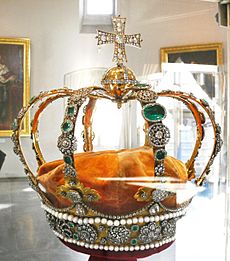
Stuttgart has five of the eleven state museums in Baden-Württemberg.
- The Old State Gallery: This museum has art from the 14th to 19th centuries. It includes works by famous artists like Rubens and Rembrandt.
- The New State Gallery: This museum has modern art. It features works by Picasso and Klee.
- The Old Castle is home to the State Museum of Württemberg. This museum shows the history of Württemberg. It has artifacts from dukes, counts, and kings. It also has items from the Stone Age.
Other top museums in Stuttgart include:
- The Mercedes-Benz Museum: This is the most visited museum in Stuttgart. It shows the 125-year history of the automobile.
- Stuttgart Art Museum: This museum focuses on modern art. It is in a large glass cube on Schlossplatz.
- The Porsche Museum: This museum showcases the history of Porsche cars.
- Hegel House (Hegelhaus): The birthplace of the philosopher Georg Wilhelm Friedrich Hegel.
- The Linden Museum: A leading museum about different cultures around the world.
- Stuttgart Tram Museum (Straßenbahnwelt Stuttgart): Displays old trams from 1868.
- The North Station Memorial: A memorial for the Jewish victims of the Holocaust.
Churches in Stuttgart
Stuttgart is home to a Protestant bishop and one of the two Roman Catholic bishops. The Pentecostal Gospel Forum is the largest place of worship in Germany. There is also a large English-speaking church, the International Baptist Church of Stuttgart.
Libraries and Archives
The Württembergische Landesbibliothek (WLB) is one of two state libraries for Baden-Württemberg. It collects and archives literature about Württemberg. The Stuttgart University Library (UBS) provides resources for research and studies.
The Central State Archive Stuttgart holds records from the State of Baden-Württemberg. The Stadtarchiv Stuttgart keeps records for the city of Stuttgart. These archives are open to the public.
Stuttgart's People
| Historical population | ||
|---|---|---|
| Year | Pop. | ±% |
| 1400 | 4,000 | — |
| 1707 | 16,000 | +300.0% |
| 1837 | 36,041 | +125.3% |
| 1900 | 166,699 | +362.5% |
| 1920 | 315,796 | +89.4% |
| 1930 | 377,461 | +19.5% |
| 1940 | 454,600 | +20.4% |
| 1950 | 497,677 | +9.5% |
| 1961 | 637,539 | +28.1% |
| 1971 | 632,947 | −0.7% |
| 1981 | 583,001 | −7.9% |
| 1991 | 579,988 | −0.5% |
| 2001 | 587,152 | +1.2% |
| 2011 | 585,890 | −0.2% |
| 2022 | 610,458 | +4.2% |
| Population size may be affected by changes in administrative divisions. Source: | ||
Stuttgart has a population of about 630,000 people. It is the 6th largest city in Germany. The population grew a lot in the 1960s due to its car companies like Mercedes-Benz and Porsche. Many people from other countries moved here for work.
Immigrant Communities
Today, more than half of Stuttgart's population is not originally from the Swabian region. Many Germans from other areas moved here for jobs. Since the 1960s, many people from other countries have also moved to Stuttgart for work. These "Gastarbeiter" (guest workers) came from places like Turkey, Greece, Italy, and former Yugoslavia.
As of 2022, 47% of the city's population has a foreign background. In 2022, 27.6% of the population did not have German citizenship. The largest groups of foreign nationals include Turks, Croats, Italians, and Greeks.
Religious Diversity
Before 1534, Stuttgart was mostly Catholic. After the Protestant Reformation, it became mainly Protestant. However, the number of Protestants has decreased over time. In 2014, 26.2% of people were Protestant and 24.0% were Roman Catholic. The rest of the population, about 49.8%, belonged to other religions or no religion. This includes Muslims and Jews.
Low Unemployment
Unemployment in the Stuttgart Region is very low compared to other big cities in Germany. In November 2008, it was 3.8%. In February 2009, it was 4.7%. This shows that there are many job opportunities in the area.
City Safety
Stuttgart is one of the safest cities in Germany. In 2003, there were 8,535 crimes for every 100,000 people. This was much lower than the average for German cities. In 2006, Stuttgart ranked second safest after Munich.
City Government
Stuttgart is led by an Oberbürgermeister, which is like a mayor. After World War II, Arnulf Klett was appointed mayor. He served until 1974. Since then, the city has mostly been governed by the CDU party. Manfred Rommel, son of a famous World War II general, was also a mayor.
As the capital of Baden-Württemberg, Stuttgart is an important political center. It is where the State Parliament, or Landtag, meets. All state government departments are also located here.
In June 2009, the Greens won the most seats in the city council for the first time. This changed the balance of power in the city. This was partly due to public discussions about the Stuttgart 21 rail project.
Current Mayor
The current mayor of Stuttgart is Frank Nopper. He is from the Christian Democratic Union (CDU) party. He became mayor in 2020.
City Council
The Stuttgart city council works with the mayor to govern the city. The most recent election for the city council was on June 9, 2024. The council has 60 seats.
City Districts
Stuttgart is divided into 23 city districts. There are five "inner" districts and 18 "outer" districts. Each district has its own council and director. These districts are then broken down into smaller "quarters." There are now 152 quarters in total.
Stuttgart's Economy

The Stuttgart area is famous for its high-tech industries. Many big companies have their world or European headquarters here. These include Mercedes-Benz Group, Porsche, Robert Bosch GmbH, Hewlett-Packard, and IBM.
Stuttgart also has Germany's ninth largest exhibition center, Stuttgart Trade Fair. It is located near the Stuttgart Airport. Many smaller and medium-sized companies are also based in Stuttgart. They often focus on cars, electronics, and engineering.
The Birthplace of the Automobile
Stuttgart is known as the "cradle of the automobile." This is because the first car and motorcycle were invented here. Karl Benz invented the automobile. Then, in 1887, Gottlieb Daimler and Wilhelm Maybach started to make them in a factory.
Today, Mercedes-Benz and Porsche both have their main offices in Stuttgart. Big car parts companies like Bosch and Mahle are also here. Many magazines for car fans are published in Stuttgart too.
Science and Research
The Stuttgart region has the most scientific and research organizations in Germany. More patents and designs are registered here than anywhere else in Germany. About 45% of Baden-Württemberg's research and development (R&D) happens in Stuttgart. Over 4.3 billion euros are invested in R&D here each year.
The area has several universities and colleges. These include the University of Stuttgart and the University of Hohenheim. There are also many research institutes, like those from the Fraunhofer Society and Max Planck Society. The German Aerospace Center (DLR) also has a major office here.
Financial Services
The Stuttgart Stock Exchange is the second largest in Germany. It is only smaller than the one in Frankfurt. Many important financial companies are based in Stuttgart. There are about 100 credit institutes in the city.
Wine and Beer History
Stuttgart is the only city in Germany where wine grapes are grown right in the city. You can find vineyards in areas like Rotenberg and Untertürkheim. Wine growing in this area started way back in 1108. In the 17th century, Stuttgart was one of the biggest wine-growing communities in the Holy Roman Empire. Wine was a main source of income for Stuttgart until the 1800s.
Today, Stuttgart is still one of Germany's largest wine-growing cities. It has over 988 acres (400 hectares) of vineyards. This is because it is in the middle of the Württemberg wine region. This region is one of Germany's 13 official wine areas. The importance of wine is celebrated every year at the annual wine festival.
Stuttgart also has several famous breweries. These include Stuttgarter Hofbräu, Dinkelacker, and Schwaben Bräu.
Education in Stuttgart
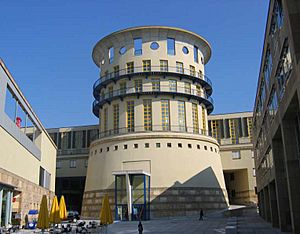
Stuttgart has been home to important German thinkers and writers. These include Georg Wilhelm Friedrich Hegel and Friedrich Schiller. The city is also known for its engineering and innovation. It has many research institutions.
Higher Education
Stuttgart has several universities and colleges:
- University of Stuttgart: Founded in 1829, it is the fourth largest university in Baden-Württemberg. It is known for engineering and technical subjects.
- University of Hohenheim: Started in 1818 for farming and forestry. Today, it also focuses on business.
- State University of Music and Performing Arts Stuttgart: Founded in 1857, it is in the city center.
- State Academy of Fine Arts in Stuttgart: One of Germany's biggest art colleges, founded in 1761.
- Stuttgart Media University: A university of applied sciences for media studies.
- Stuttgart Technology University of Applied Sciences: Founded in 1832, it focuses on technology.
Schools for Younger Students
The first Waldorf School was founded in Stuttgart in 1919. These schools follow special teaching principles. Today, there are four Waldorf schools in Stuttgart.
The Eberhard-Ludwigs-Gymnasium was created in 1668. It was a model high school that aimed to modernize education.
International School
Since 1985, Stuttgart has been home to the International School of Stuttgart. This school offers all three International Baccalaureate programs. It is one of fewer than 100 schools worldwide to do so.
Media and Publishing
One of the main offices for the public broadcasting company Südwestrundfunk (SWR) is in Stuttgart. It has several radio and TV channels. The city also has a state media center.
Stuttgart is a big center for publishing and printing. Many famous publishing houses are located here. These include Georg von Holtzbrinck Publishing Group and Ernst Klett Verlag (which makes schoolbooks).
The local newspapers are Stuttgarter Zeitung and Stuttgarter Nachrichten. There are also smaller local papers. The American Forces Network (AFN) also has a station here for US military members.
Transportation
On March 1, 2008, Stuttgart started a low emission zone. This helps improve air quality in the city. All vehicles entering this zone must meet certain emission standards.
City Transport
Stuttgart has a light rail system called the Stuttgart Stadtbahn. In the city center, it runs underground. The stations are marked with a 'U' symbol. Stuttgart also has a large bus network. These are run by the Stuttgarter Straßenbahnen AG (SSB). The outer areas of Stuttgart are served by the Stuttgart S-Bahn, a suburban railway.
Stuttgart has a special rack railway called the Zahnradbahn. It runs between Marienplatz and Degerloch. It is the only urban rack railway in Germany. There is also a funicular railway in the Heslach area. In Killesbergpark, there is a miniature railway that runs in the summer.
Train Connections
Stuttgart is a major hub for Germany's train networks. You can take trains to most other big German cities. There are also international trains to places like Strasbourg, Vienna, Zürich, and Paris.
Long-distance trains stop at Stuttgart Hauptbahnhof, the city's main train station. Local trains also use this station. Stuttgart also has a freight center for cargo trains.
The Stuttgart 21 Project
After many years of discussions, plans were approved in October 2007 to change the main train station. The Stuttgart 21 project involves moving the existing above-ground station underground. This project started in 2010 and is expected to be finished in 2025.
Air Travel
Stuttgart is served by Stuttgart Airport (STR). It is an international airport about 8 miles (13 kilometers) south of the city center. You can reach the airport in 30 minutes using the S-Bahn. Stuttgart airport is Germany's only international airport with one runway.
Road Travel
Stuttgart is connected by major highways, like Autobahn A8 and Autobahn A81. Many other expressways connect Stuttgart to its suburbs. Because of the hilly area, there are many road tunnels in and around Stuttgart.
Waterways
Stuttgart has an inland port in Hedelfingen. It is located on the Neckar river.
Sports in Stuttgart
Football Fun
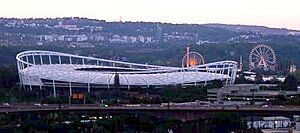
Football is very popular in Stuttgart. The most famous team is 'The Reds', VfB Stuttgart. They play in the German Bundesliga, which is the top league. VfB was founded in 1893 and has won five German titles. Their home stadium is the MHPArena in Bad Cannstatt.
'The Blues', Stuttgarter Kickers, are another important football team. They play in a lower division at the Gazi Stadium.
Other Sports
- Handball: TV Bittenfeld plays in the men's Handball-Bundesliga.
- Volleyball: The women's team Allianz MTV Stuttgart plays in the top German league. They have won German championships and cups.
- Ice Hockey: Stuttgart has two main ice hockey teams, the Stuttgart Rebels EC and the Bietigheim Bissingen Steelers.
- Water Polo: The strongest local team is SV Cannstatt.
- American Football: Stuttgart has three American Football teams: the Stuttgart Silver Arrows, the Stuttgart Scorpions, and Stuttgart Surge.
- Australian Football: The Stuttgart Emus play Australian Football.
- Tennis: TC Weissenhof is a successful women's tennis team.
- Field Hockey: HTC Stuttgarter Kickers is a very successful field hockey club.
Big Sporting Events
Stuttgart has hosted many major sports events. These include the 1974 FIFA World Cup and the 2006 FIFA World Cup. Six matches were played at the Gottlieb Daimler Stadium (now MHPArena). Stuttgart was also the European Capital of Sport in 2007. It hosted events like the UCI World Cycling Championships.
Other famous sports venues include the Weissenhof tennis courts, where the annual Mercedes Cup is played. The Porsche Arena hosts tennis, basketball, and handball. The Schleyerhalle is used for boxing, gymnastics, and cycling.
International Connections
Stuttgart has many twin towns and sister cities around the world. These partnerships help build friendships and understanding between different cultures.
Twin Towns and Sister Cities
- St Helens, United Kingdom (1948)
- Cardiff, United Kingdom (1955)
- St. Louis, United States (1960)
- Strasbourg, France (1962)
- Mumbai, India (1968)
- Menzel Bourguiba, Tunisia (1971)
- Cairo, Egypt (1979)
- Łódź, Poland (1988)
- Brno, Czech Republic (1989)
- Samara, Russia (1992)
Some city districts also have twin towns:
- Bad Cannstatt is twinned with Újbuda (Budapest), Hungary.
- Vaihingen is twinned with Melun, France.
- Zuffenhausen is twinned with La Ferté-sous-Jouarre, France.
Friendship Cities
Stuttgart also has friendly relations with:
- Ōgaki, Japan
- Nanjing, China
- Shavei Tzion, Israel
Images for kids
-
The 216 meter (709 ft) Fernsehturm Stuttgart (Stuttgart Television Tower) at night
-
The Hegel Museum, birthplace of Hegel
-
Stuttgart annual Christmas Market
-
The mild climate and hilly landscape are perfect for viticulture, as the Romans discovered. Pictured are vineyards near Obertürkheim.
-
Neckar river flowing through Hedelfingen and Obertürkheim
See also
 In Spanish: Stuttgart para niños
In Spanish: Stuttgart para niños


